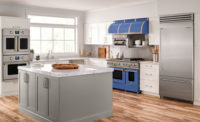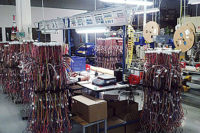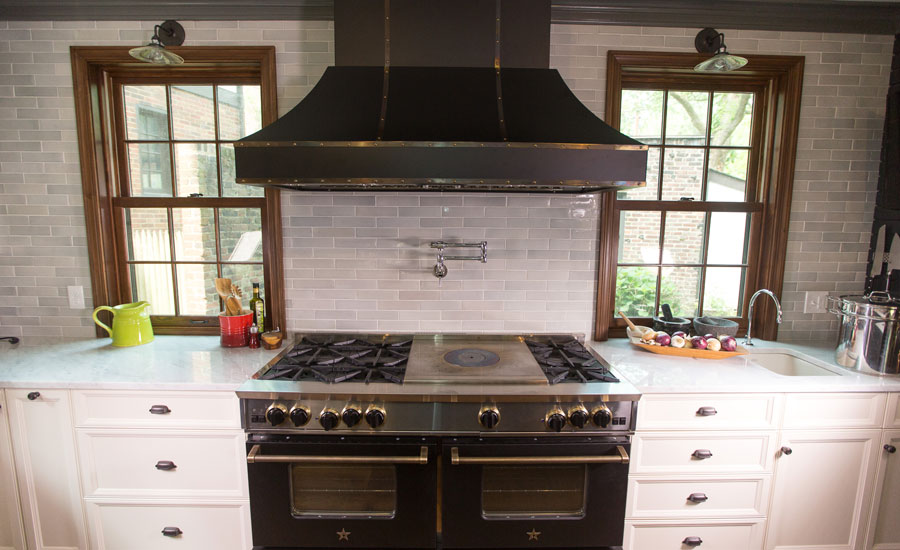Demand Rises for Kitchen Appliances with Matte Finishes

A range with a dark matte finish compliments a stainless steel refrigerator with matching handles. Source: BlueStar

The demand for appliances with a matte finish, such as this range, hood and refrigerator, are on the rise. Source: BlueStar

Appliances with matte finishes often have hardware to match the surrounding kitchen cabinetry. Source: BlueStar



The first major renovation in a home often brings down the wall between the kitchen and living room, creating an open floor plan. It also reveals a direct line of sight from the soft furniture textures of the living space to the hard surfaces of a kitchen.
“That really questions these harsh finishes and material choices for appliances,” says Maggie Bellinger, the lead industrial designer for GE Appliances, a Haier company. “Stainless steel is harsh, and it can be perceived as cold and clinical. So we wanted to introduce slate, something a little softer with a matte look to really harmonize with the rest of the furniture in your home.”
Matte finishes for refrigerators, dishwashers, ranges and hoods are growing in popularity along with open floor plans, but also alongside other societal trends reacting against harsh modern environments of LCD screens, noise pollution and digital clutter. That desire for more natural, muted and textured coatings—closer to the colors found in nature—is not reflected solely in the appliance market. Fiona Levin-Smith, director of marketing for IFS Coatings, says the trend was first apparent in automotive, before spreading across many market segments including fashion, architecture and appliances.
Societal trends behind the demand for matte finishes were reflected in IFS Coatings’ 2017-2018 color trend report, Levin-Smith explains. “The whole idea that we value the natural world, and the connection that we have with it, goes across cultures. Nature is a way to improve your mind and soul,” she says. “In nature you don’t often get a straight shot of color, you tend to get little textures, you get the matte type of look.”
To learn more about the matte finishes trend in kitchen appliances, appliance DESIGN spoke more with Bellinger, Levin-Smith and Ann Muth, director of marketing at BlueStar.
appliance DESIGN: How else do you see matte finishes fitting in with kitchen trends?
Ann Muth: People are looking to blend colors with their cabinetry. I use the word “blend” very purposefully, because there was a trend for a while where everyone was trying to totally have their appliances disappear into their cabinetry. So everything was paneled. And if you had darker cabinets, people were putting in black appliances, or white cabinets and white appliances, just to make everything look cohesive. Now they want the appliances to stand out, but not so much with that high gloss. So the matte color really brings that muted tone that helps blend with the cabinetry and the walls that are surrounding them.
Bellinger: It’s very interesting, because within the North American market especially, consumers gravitate towards suites. So they’re very interested in matching their appliances. That’s not to say that when one goes out you want to buy an entire suite. But the idea here was that with slate and black slate, we kept the stainless handle to tie it back into other stainless finishes. Let’s say they needed to replace one product from their stainless suite, and they were considering slate, they have a unifying piece and that’s the handle. The handle would be identical to a stainless suite handle.
AD: What appliances are you seeing the matte trend with the most?
Muth: The largest portion of BlueStar’s sales actually comes from free-standing ranges. And we have seen a big uptick in matte orders in our ranges, and then corresponding matching appliances depending on what else you’re purchasing from us. So that would translate to refrigeration, dishwasher panels and even ventilation. People, especially if they’re doing their range, they’re looking to match their hood in some way or another or have a complementary hood. So matte would translate here, as well. The majority of it is panels, when people are looking at hardware and things on other parts of their fridges and appliances, they’re potentially trying to match to the hardware that’s on the cabinetry.
Levin-Smith: We create powder coating for some fixture and fitting companies, as well. And I think we’ve seen that. In one of the other trends that I mentioned, which we call “refreshing radiance,” we’ve seen some darker, romantic colors. A lot of them focus on traditional, warmer shades and more natural materials, so, just like Ann (Muth) said with the bronzes. We’ve seen matte black, we’ve seen gun metal, and we’ve seen a kind of rose gold color…and those all make up that trend. In fact we have seen an uptick in that type of color across the board, not just in appliances.
AD: Are you seeing this trend in the laundry room?
Bellinger: I’m not seeing this in the laundry room. The glossy finish dominates there because of the aggressive nature of laundry detergent and the gummy buildup that detergents create. So maybe that’s why it’s not there yet.
AD: I suppose people aren’t opening up their floor plans into the laundry room?
Bellinger: Not in our market, that’s absolutely correct. In Europe, you see laundry units in the kitchen all the time. And even there they tend to be a high-gloss. But high gloss is more popular in Europe in general; it fits with their kitchen aesthetic.
AD: What are the other practical benefits to matte finishes? Is it durable?
Bellinger: It resists fingerprints, and then the metallic flake provides that perceived durability. It’s just as durable as stainless (steel). With scratching and dents, the neat thing about a matte finish with dents is you’re not going to get a harsh highlight like you would with a high-gloss finish. It’s not going to scream out at you like it’s been dented.
AD: Is this trend reflected across all price points?
Muth: I would say matte black, which is very generic, can definitely be seen in the lower-end market. And then as you get into the higher-end market, which is where BlueStar plays, you get to see that level of customization where people are choosing it from a design perspective and are choosing things beyond black. They might be going to a blue or a white or a burgundy. I’m seeing it more in neutral tones, but that’s just me speaking on behalf of BlueStar.
Bellinger: I would say it’s up and down the line. It’s absolutely low-end all the way up to high-end. We have it from down to our GE brand all the way up to our Cafe brand, which is the more premium, restaurant-inspired industrial brand. So even within our space you’ll see it across multiple price points.
AD: What do you predict down the road?
Bellinger: I think stainless will continue to evolve; it has such great qualities about it, which is why it has maintained its status as the lead premium finish. So the introduction of matte, I think, is very interesting, and we may start to see even more matte finishes and more growth within that neutral space. But I do see stainless continuing to evolve and then I see a stainless appearance behind glass coming to the North American market as well. It’s been popular in Europe for quite some time.
Looking for a reprint of this article?
From high-res PDFs to custom plaques, order your copy today!









